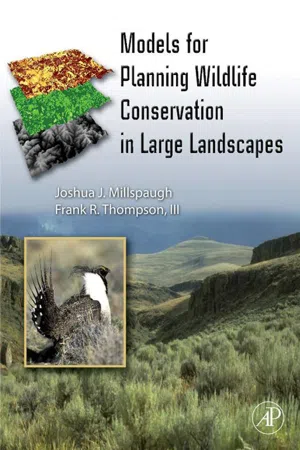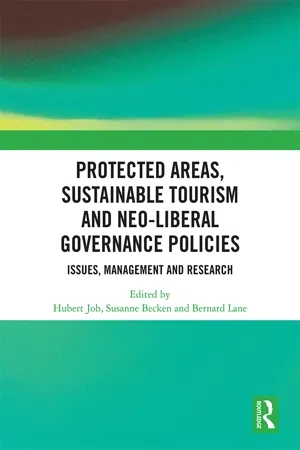Geography
Conservation Planning
Conservation planning involves the systematic assessment of natural resources and the development of strategies to protect and sustainably manage them. It aims to balance human needs with the preservation of biodiversity and ecosystems. This process typically involves identifying priority areas for conservation, setting goals, and implementing measures to achieve long-term environmental sustainability.
Written by Perlego with AI-assistance
4 Key excerpts on "Conservation Planning"
Learn about this page
Index pages curate the most relevant extracts from our library of academic textbooks. They’ve been created using an in-house natural language model (NLM), each adding context and meaning to key research topics.
- eBook - ePub
Land and Limits
Interpreting Sustainability in the Planning Process
- Richard Cowell, Susan Owens(Authors)
- 2005(Publication Date)
- Routledge(Publisher)
3 While acknowledging this complexity, and remaining sensitive to its policy implications, we focus in our discussion of nature conservation on the (extending) range of species and ecosystems that have become the subject of widespread contemporary concern: many of the latter are semi-natural, and their survival depends upon a dynamic concept of conservation. As elsewhere in the book, we develop the argument primarily with reference to Britain, commenting on the situation in other countries where appropriate. However, it is important to recognise that while institutional arrangements remain specific to particular countries, nature conservation policies have had an increasingly significant international dimension, not least because of the Convention on Biological Diversity, signed by 167 countries at Rio de Janeiro in 1992 (UNCED 1992b). In discussing these policies, and their connections with land-use planning, we concentrate on the strategic level rather than on details of management, regulation and development control, although we touch upon these where they show how policies are being interpreted on the ground. Our aim is to explore key issues at the interface of planning and nature conservation and appropriate frameworks for their treatment within the political process.We begin by considering the effects of a transition in conservationist thought from a reactive, primarily site-based approach to a more strategic and holistic view based on concepts of biodiversity. Land-use planning continues to be of great importance for site protection, but increasingly it is seen as a forum within which a more proactive and strategic approach to nature conservation can be defined and pursued. And since, in many areas, conservation of what has survived is not enough, it is an approach that must encompass increasing attention to habitat restoration and enhancement. In the UK, these changes are reflected in legislation and in guidance to local planning authorities (from government, statutory agencies and non-governmental organisations), and are set within an increasingly ambitious European policy framework for the protection of biodiversity. At the same time, emerging interpretations of sustainable development, particularly those grounded in concepts of environmental capital and capacity, have been influential in planning and nature conservation policy communities. We examine the novelty, potential and problems of these approaches, confirming our thesis that their initial enthusiastic reception left a number of fundamental questions unanswered. - Joshua Millspaugh, Frank R. Thompson(Authors)
- 2011(Publication Date)
- Academic Press(Publisher)
Fischer and Lindenmayer 2006 )—a shift that is also seen as facilitating the incorporation of ecological process into Conservation Planning and land management.Incorporating Ecological Process
Geographic approaches to Conservation Planning have been dominated by the examination of patterns of noteworthy biodiversity features across the landscape (Pressey 2004 ). These biodiversity patterns manifest from a complex interaction of ecological processes (e.g., species dispersal, spatially explicit demographics, disturbance, succession, interspecific interactions, primary productivity) with human uses of the landscape (e.g., subsistence, land use conversion, resource extraction). These interactions are the drivers of ecosystem dynamics and the transitory nature of species occupancy patterns across the landscape (Sarkar et al. 2006 ). The observed temporal turnover in species begs the question: “Can static conservation designs protect the full complement of species suggested by the planning analyses?” (Cabeza and Moilanen 2001 ).Unfortunately, conservation science has yet to determine the best approaches for including the underlying ecological and socioeconomic processes into geographical approaches to Conservation Planning (Williams et al. 2005 ). For this reason, there is a growing recognition that the biodiversity patterns used to justify a particular conservation design may not be conserved over time. This realization was the motivation behind the efforts of Leroux et al. (2007) to examine the effects of disturbance on the effectiveness and efficiency of static conservation designs. The risks associated with ignoring dynamics varied across conservation targets with some targets (population levels of a focal species) failing to be maintained in a dynamic world, whereas other targets (vegetation representation) were conserved with a high probability under most circumstances (Leroux et al. 2007- eBook - ePub
Urban Nature Conservation
Landscape Management in the Urban Countryside
- Stephen Forbes, Tony Kendle(Authors)
- 2013(Publication Date)
- Taylor & Francis(Publisher)
5 Biogeography and Conservation Planning in the Urban CountrysideIt is becoming increasingly apparent that many of the assumptions underlying Conservation Planning have been too simplistic to guide management accurately, or to explain adequately all of the relationships seen between species and reserves. Slowly ecologists are developing an understanding of the ways in which broader habitat patterns, comprising shapes, sizes, internal structure and the spatial relationship between all of these and between the habitats and the surrounding landscape influence the diversity of species found within a reserve or wildlife area.The discipline of landscape ecology has been defined by the UK branch of the International Association of Landscape Ecology asthe interactions between the temporal and spatial aspects of a landscape and its flora, fauna and cultural components (Griffith, 1995).In many ways it is a direct extension of the subject of biogeography.The subject grew largely out of the interests of central European biogeographers in the regional and local scale patterns and processes in the landscape (Naveh and Liebermann, 1994), although the terminology inevitably has become entangled and confused with those aspects of work of the landscape professions which have an ecological orientation, such as have been discussed in earlier chapters regardless of their scale. For the purposes of this chapter, the term landscape ecology is used in keeping with the above definition – the objective is to review the interaction between the pattern and distribution of habitats and sites within the urban fabric and to consider how the relationships between them may affect their function.The significance of such a study lies in its potential contribution towards strategic planning and the identification of areas where green space creation, protection and management strategies may be targeted towards regional benefits. It is increasingly the case that environmental planners across Europe are using principles of landscape ecology as guides for determining policy and in some countries such as Holland there are extensive programmes of proactive green space designation and habitat creation that are determined by the perceived benefits arising from improvements in the pattern and distribution of open land (see papers in Griffith, 1995). Many of these applications are focused on urban areas, where constraints on overall land availability mean that clear guidance is often needed for prioritizing site protection or purchase. - eBook - ePub
Protected Areas, Sustainable Tourism and Neo-liberal Governance Policies
Issues, management and research
- Hubert Job, Susanne Becken, Bernard Lane(Authors)
- 2020(Publication Date)
- Routledge(Publisher)
Protected Areas in a neoliberal world and the role of tourism in supporting conservation and sustainable development: an assessment of strategic planning, zoning, impact monitoring, and tourism management at natural World Heritage Sites Hubert Job, Susanne Becken and Bernard LaneABSTRACT Societies collapse when there is an increasing natural resource scarcity and growing stratification of society into rich and poor. The neoliberal world of targets, business plans and short term economic justification in which we live exacerbates these risks to society. It is imperative to find new ways of governing natural ecosystems that protect them from these risks and allows usage that helps close the development gap. Tourism in Protected Areas (PAs) is one important vehicle to achieve sustainable conservation and development outcomes. This paper highlights that the increasing focus on promoting human activity, especially tourism, in and around PAs is increasingly enshrined in the mandate and governance structures of United Nations Educational, Scientific and Cultural Organisation natural World Heritage Sites and Biosphere Reserves. It reviews strategic planning, zoning, impact monitoring, and tourism management by analysing all 229 natural World Heritage Sites, revealing that both overall strategic planning and tourism planning in these sites need improvements, notably through more consistent monitoring systems. The paper concludes by exploring the benefits of embedding World Heritage Sites into Biosphere Reserves, with a particular focus on core zoning, regional product development, and improved monitoring standards, and suggests ways to disseminate good practice worldwide to all types of PAs.Introduction: the wider context
Concern about planetary limits and the risks humankind is facing as a result of increasing environmental destruction is growing (Hall & Day, 2009). Preserving natural resources and environments, including through the mechanism of Protected Areas (PAs), has long been recognised as vital for societies to continue to exist and thrive. Diamond (2005), in his book on why societies collapse, proposed a five-point framework to capture the complexity of the human–environment relationship and long-term success. He suggests that large-scale decline in either human population and/or socioeconomic complexity is influenced by serious environmental problems, climate change (natural or anthropogenic), conflict with trade partners or neighbouring enemies, and problems arising from society’s own political, economic, and social arrangements. Building on this earlier work, and learning from patterns of societal collapse over history, Motesharrei, Rivas, and Kalnay (2014) extracted two key features that appear to influence whether societies collapse or not. One was the increasing scarcity of natural resources (the result of exceeding an ecological carrying capacity), and the other one was a heavy stratification of society into rich elites and poor commoners. Under the current conditions of an increasingly unequal society, Motesharrei and co-workers suggested that collapse is difficult to avoid; however, it is possible if we can reach an equilibrium in which the depletion rate of nature per head of population is sustainable, and if this depletion is more equally distributed.



